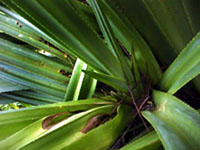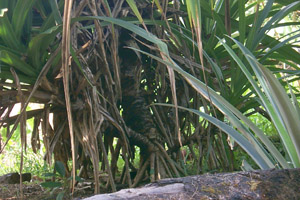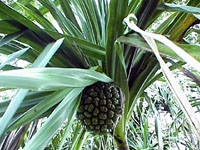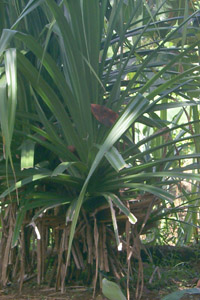







Family name: Pandanaceae (Pandanus family)
English names: Screwpine, Pandanus
Pohnpeian name: Kipar
Kosraen name: Mweng
Chuukese name: Fach
Yapese name: Choy
Habit: Shrub or tree. It grows up to 25 feet (8m) or more in height, with aerial prop roots and prickly stem.
Leaves: Linear leaves spirally arranged at branch tips, up to 6 feet (2m) or more length, M-shaped in cross section, margins and midrib of lower surface prickly (serrate).
Flowers: Male flowers tiny, in dense, white inflorescences with large white bracts. Female flowers in a head. Both appear at branch tips.
Fruit: Globose shape, separated pieces (phalanges) are tooth-like shape (angular), wedge-shape orange sections (prudes) are edible, husk fibrous, one to several-seeded.
Location & Habituation: Pandanus tectorius is native to all the archipelagoes of Micronesia. It is found all over Micronesia due to its growing advantage on rocky and sandy shores of atolls and high islands. Micronesia is mostly consists of atolls and high islands, thus abets the growth of Pandanus tectorius. Pandanus tectorius is a terrestrial plant; it grows on the ground.
Uses: Pandanus tectorius is one of the most useful trees in Micronesia. The leaves, which are the most useful part of the plant, are woven or plaited into mats, thatch, sails, baskets, hats, local fans, marmars, anticrafts, and many other items. Tip of prop roots are eaten and are often used as native medicine in Pohnpei and maybe in other Micronesian islands as well. The fruit is a major source of food in Micronesia especially on the atolls. They can be eaten raw or cooked. Either way, it is very healthy. Besides serving as a food, its fibrous helps clean the teeth, acting as a natural dental floss.
Overall Summary: In English this cultivated tree is known as the "Screwpine." Kipar in Pohnpei; Fach in Chuuk; Mweng in Kosrae; and Choy in Yap. Pandanus tectorius is native to Micronesia. It was brought to Pohnpei by the early Micronesians. Pandanus tectorius is a wide-branched tree that grows up to heights of about 25 feet (8m). The prickly trunk has few to many aerial prop roots and the leaves are long (up to 6 feet, 3m) with serrated magins (thorny leaf edges). The large edible fruit is an aggregate of many angular, wedge-shaped orange sections (drupes). Although it does grow from seed, the fruit rarely does produce seed. This is a strong indication that people have been reproducing Pandanus tectorius by planting cuttings for many generations. Besides serving as a food, the fibrous helps clean the teeth, acting as a natural dental floss. The dried leaves are used to weave hats, baskets, mats, and other items. The tips of the aerial roots are used in traditional medicine.
Specimen photographed and web page created by: Jenson Santos, October 1998.
Culturally Significant Plant -- Pandanus Tree Mwokillese: Kupar
The pandanus tree is a very important tree to the Mwokillese people. To this day, the pandanus tree still holds special meaning to them. Because of this tree, people gather together for feast, activities, or just to enjoy the day. They use this plant to build houses, and to weave mats, hats, even masks for the warrior dances. They also use this plant as a means of food and, in the old days, dental floss.
All the parts of the tree has it's own unique use. The bark, for example, was used in the old days to build houses for the people of Mwokil. They thought that this was the strongest tree that could support their houses. It was used as the foundation to the house. Then they completed it by using the leaves to make thatched roofs. But then again that is not the only use for the leaf. The people had a lot of warrior dances that needed masks to be used. Since there were no cardboard boxes to make masks with and no stores to buy them at, they had to make the masks locally. These, the masks, are held dear to the old people who are still alive today and their kids. The mats that they slept on and the hats that they wore to block the heat of the sun were also made from the leaves. The fruit also comes in handy. Back then, they had a season for the pandanus tree. Whenever the fruits started getting ripe. They would harvest the crop and gather together to make whatever kinds of recipes they could. They would boil it and add grated coconut to it, or make a special plate from it and all sorts of things that we, now-a-days, don't do anymore.
In these days, the Mwokillese on Pohnpei would look forward to going down to the Mwokil Atoll. The Mwokillese on this island don't weave mats because they are too caught up with the western technologies on this island. If they don't have mats they buy them. This is why it never stops to excite them thinking about all those mats that they know would be waiting for them. Not only are they long-lasting than the ones in the stores, but they are also FREE. Each lady would be very proud of her mat if she got one. They would brag about how many they have or how new it looks or just because they have one. The Mwokil Atoll uses these mats as their only means of gifts to everyone and anyone who visits the atoll. The fruit attracts a lot of visitors towhere it grows. When it is ripe, all family members gather together to enjoy the fruits and, of course, the day.
These are only just some of the reason why the pandanus tree is so special to us.
-Sharon Lebehn-